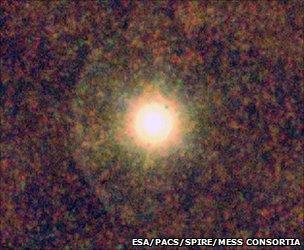Old star wallows in 'steam bath'
- Published

CW Leonis may be twice a massive as our Sun but its radius is about 250 times bigger
Europe's Herschel space telescope has looked on as an old giant star wallows in a "steam bath".
CW Leonis, sited some 500 light-years from Earth, has long been known to be surrounded by a shroud of water.
But Herschel's exquisite ability to track the molecule in space means it can show the water lies close to the star and reaches a sweltering 700C.
Scientists tell the journal Nature that ultraviolet light from nearby stars is driving the production of water vapour.
"Herschel really is the most amazing water detector," lead researcher Dr Leen Decin from the Katholieke Universiteit Leuven, Belgium, told BBC News.
The presence of a gigantic cloud of water around CW Leonis was originally detected in 2001 by the Submillimeter Wave Astronomy Satellite (Swas).
At first, scientists thought the water could have come from comets, or even planets, that had been obliterated by this puffed up star.
The idea that the water could be being produced around the star itself did not seem plausible because CW Leonis had reached a stage in its life when its ageing nuclear core was churning out colossal quantities of carbon.
This "sooty exhaust" would have been expected to take up any free oxygen in the vicinity of the star to make carbon monoxide - a very stable molecule.
But Herschel's PACS and SPIRE instruments have a remarkable sensitivity to water, seeing it in many different states of excitation. These spectrometers were able to confirm that CW Leonis' water was present very close to the star, all the way down to near its surface - far too close to have come from comets.
"The abundances are high in all the excitation lines," explained co-author Professor Mike Barlow of University College London, UK.
"You can call it water vapour and it's everything from cool, to warm, to hot - right up to levels where you need temperatures of 1,000 kelvin or so (725C)."
The scientists working on Herschel propose that a previously unsuspected chemical process is at work, one in which ultraviolet light from nearby bright, hot stars is breaking up the carbon monoxide and releasing its oxygen atoms to join up with hydrogen and form water molecules.
In an aged star like CW Leonis, which is also throwing off a large envelope of gas and dust, such a chemical process ought normally to be blocked - the UV light should be prevented from getting through to the carbon monoxide to work on it.
But Herschel and other telescopes have shown the stellar wind billowing away from CW Leonis to be extremely clumpy, allowing the UV light to penetrate deep in towards the star and trigger the production of water.
"This is really exciting, since it is the first time that we have seen a lot of carbon and water molecules co-existing close to a very luminous, but dying, star," said Dr Decin.
"Carbon and water are two of the major the building blocks for life as we know it on Earth. The same mechanisms triggered by ultraviolet light might have played a crucial role in prebiotic processes on the early Earth."
The European Space Agency's (Esa) Herschel observatory was launched in 2009.
Its quest is to study how stars and galaxies form, and how they evolve through cosmic time.
Herschel carries the largest mirror (3.5m) ever sent into space. Its instruments are sensitive to light at long wavelengths - in the far-infrared and sub-millimetre range.
By getting above the Earth's water-filled atmosphere, the telescope is able to study the molecule's prominence elsewhere in the Universe.
- Published1 July 2010